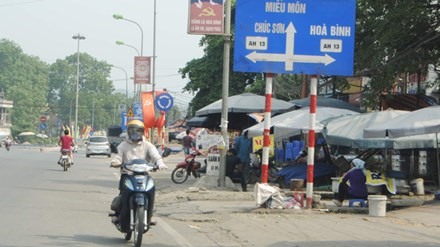 Society
Society

The development of satellite urban areas is expected to help Hà Nội share the burden of accommodation, training, industry and services, but resources are needed to develop this model, according to experts.
 |
| The Xuân Mai satellite urban area is quite slovenly. Experts said that resources are needed to develop the satellite urban model. – Photo tienphong.vn |
HÀ NỘI – The development of satellite urban areas is expected to help Hà Nội share the burden of accommodation, training, industry and services, but resources are needed to develop this model, according to experts.
Under the Masterplan for Hà Nội’s socio-economic development to 2020, with a vision to 2030, the capital city will have five satellite towns with different functions and characteristics, including Hòa Lạc, Sơn Tây, Xuân Mai, Phú Xuyên and Sóc Sơn.
The main role of the Hoà Lạc satellite town will be to serve science and technology development and training, while Sơn Tây satellite town has been selected as the urban area of historic culture and resort tourism.
Xuân Mai satellite town will be the urban area of services - industries supporting the development of small industries and craft village systems; Phú Xuyên satellite town is dedicated to industry, transportation hubs, and transshipment of goods; and Sóc Sơn satellite town will focus on the development of industry and air services, eco-resort tourism, medical centers and universities.
Director of the Institute of Construction and Urban Economics, Phạm Sỹ Liêm, said at a recent conference on satellite urban areas for Hà Nội that these are designed to ease the burden on cities, particularly coping with such “diseases” as pollution, traffic congestion, infrastructure shortage and social ills.
The head of the Hà Nội Institute of Socio-economic Development Study, Nguyễn Hồng Sơn, said satellite towns were effective and necessary solutions to the population growth, expected to reach 6.2 million by 2020-2030, and to the pressure on infrastructure and environmental pollution in the city centre.
The number of vehicles in Hà Nội keeps increasing, reaching 5.4 million motorbikes and 600,000 cars by September this year, which leads to regular traffic jams.
However, Hà Nội is facing many difficulties in building the satellite town as planned.
Former vice chairman of the municipal People’s Council, Lê Văn Hoạt, said there were still no policies and programmes to encourage the development of satellite urban areas. The city also faced challenges in mobilising investment for developing the infrastructure, he said.
The development of satellite urban areas requires huge amounts of capital, while the budget earmarked for building and developing satellite urban areas remains limited, according to Sơn.
Investment in recent years focussed on developing infrastructure for the city centre, not for suburban areas, he said.
Participants at the conference agreed that it was harder to attract investors when the infrastructure and planning system was yet to be completed.
Given Hà Nội’s lack of preferential policies to develop satellite urban areas, many investors decided to invest in neighbouring provinces such as Thái Nguyên and Bắc Ninh, they said.
Another difficulty facing the development of satellite urban areas is the population spread, according to former vice chairman Hoạt. Encouraging people to move to satellite towns is a key to their success but the habit of house ownership also hinders this task. Not many people who own a house in the city centre want to move to satellite towns to live.
The head of the Hà Nội Institute of Construction Planning, Nguyễn Trúc Anh, said Hà Nội would need to have mechanisms and policies as well as supporting services to attract investment in satellite urban areas. Measures to attract city residents to live and work in satellite towns were also important, he said.
Many participants suggested that Hà Nội develop a transport system to connect the city centre with satellite towns. However, all agreed that this, too, would require investment resources. - VNS




